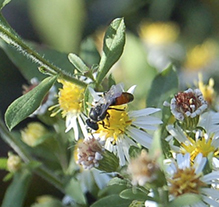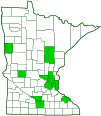Davis’s cuckoo sweat bee
(Sphecodes davisii)
Conservation • Description • Habitat • Ecology • Distribution • Taxonomy
Conservation Status |
|
|||||||
| IUCN Red List | not listed |
|||||||
| NatureServe | NNR - Unranked SNR - Unranked |
|||||||
| Minnesota | not listed |
|||||||
Description |
||
Davis’s cuckoo sweat bee is a small, kleptoparasitic, wasp-like bee. It occurs in the United States from Maine to New York, west to eastern North Dakota and Nebraska, and in southern Ontario Canada. The male is 5⁄16″ (8 mm) in length. The body is wasp-like. This is the feature that gives the genus its scientific name Sphecodes, which is Greek for “wasp-like”. The head and thorax are black, and the abdomen is bright blood red. This is the feature that gives the genus its common name. The head is entirely black and much wider than long. The compound eyes slightly converge below. The jaws (mandibles) are mostly black, dark reddish near the tip. The tongue is short. The antennae are black. On the female they have 12 segments, a scape and pedicel at the base and a whip-like section (flagellum) with 10 segments (flagellomeres). The first flagellomere is short, slightly wider than long. The remaining segments are slightly longer than wide. On the male the antennae have 13 segments. There is just a single line-like groove extending downward from the base of each antenna (subantennal suture). The face is closely and coarsely pitted (punctate). The lower half of the face is densely covered with white hairs. The top of the head (vertex) is very densely punctured. The thorax is dull, entirely black, and densely and coarsely covered with deep punctures. There are branched hairs on the pronotal lobe, but this cannot be seen without a microscope. The small plate between the wing bases (scutellum) is dull, black, and coarsely punctured. The abdomen is smooth and shiny. On the male it is red in the middle, the first abdominal segment is black, and the rear half is mostly black. On the female it is similar, but the first segment is always red, and the rear half is usually entirely red, sometimes blackened just at the very tip, sometimes colored like the male. It has comparatively few widely scattered minute punctures. The wings are mostly translucent, with dark veins and a dark cell (stigma) on the leading edge (costal margin) just before the marginal cell. The basal vein is strongly arced at the base, like the letter J. There are three submarginal cells. The first cell is longer than the third cell. On the hind wing, the lobe at the base (jugal lobe) is longer than the submedian cell. The legs are wasp-like, slender, covered with short hairs, and almost entirely black. The last part of each leg (tarsus), corresponding to the foot, has 5 segments. The end segment is paler reddish-black. Since the female does not provision a nest, her legs have no pollen collecting hairs (scopa). |
||
Size |
||
Male: 5⁄16″ (8 mm) |
||
Similar Species |
||
Habitat |
||
|
||
Ecology |
||
Season |
||
July to October |
||
Behavior |
||
Females can often be seen hovering above the ground in search of a nest of a potential host. |
||
Life Cycle |
||
The female enters the nest of another bee, usually one in the genus Halictus, Lasioglossum, Augochlora, Augochlorella, or Augochloropsis. She kills the host eggs and lays one egg of her own. |
||
Larva Food |
||
|
||
Adult Food |
||
Flower nectar |
||
Distribution |
||||
|
Sources |
|||
| 12/26/2022 | ||||
Occurrence |
||||
|
||||
Taxonomy |
|||
Order |
Hymenoptera (Ants, Bees, Wasps, and Sawflies) | ||
Suborder |
Apocrita (Narrow-waisted Wasps, Ants, and Bees) | ||
Infraorder |
Aculeata (Ants, Bees, and Stinging Wasps) | ||
Superfamily |
Apoidea (Bees and Apoid Wasps) | ||
| Epifamily | Anthophila (bees) | ||
Family |
Halictidae (sweat bees) | ||
Subfamily |
Halictinae (sweat and furrow bees) | ||
Tribe |
Sphecodini | ||
Genus |
Sphecodes (blood bees) | ||
Synonyms |
|||
|
|||
Common Names |
|||
Davis’s cuckoo sweat bee |
|||
Glossary
Costal margin
The leading edge of the forewing of insects
Flagellomere
A segment of the whip-like third section of an insect antenna (flagellum).
Punctate
Dotted with pits (punctures), translucent sunken glands, or colored spots of pigment.
Scopa
A brush-like tuft of hairs on the legs or underside of the abdomen of a bee used to collect pollen.
Scutellum
The exoskeletal plate covering the rearward (posterior) part of the middle segment of the thorax in some insects. In Coleoptera, Hemiptera, and Homoptera, the dorsal, often triangular plate behind the pronotum and between the bases of the front wings. In Diptera, the exoskeletal plate between the abdomen and the thorax.
Stigma
In plants, the portion of the female part of the flower that is receptive to pollen. In Lepidoptera, an area of specialized scent scales on the forewing of some skippers, hairstreaks, and moths. In other insects, a thickened, dark, or opaque cell on the leading edge of the wing.
Tarsus
On insects, the last two to five subdivisions of the leg, attached to the tibia; the foot. On spiders, the last segment of the leg. Plural: tarsi.
Visitor Photos |
|||||
Share your photo of this insect. |
|||||
| This button not working for you? Simply email us at info@MinnesotaSeasons.com. Attach one or more photos and, if you like, a caption. |
|||||
Bob Payton |
|||||
 |
|||||
MinnesotaSeasons.com Photos |
|||||
|
|||||

Visitor Videos |
|||
Share your video of this insect. |
|||
| This button not working for you? Simply email us at info@MinnesotaSeasons.com. Attach a video, a YouTube link, or a cloud storage link. |
|||
Other Videos |
|||

Created: 12/28/2022
Last Updated:




